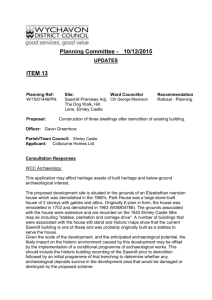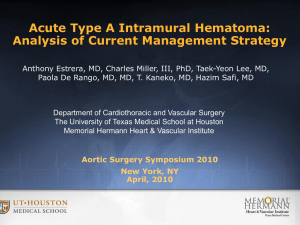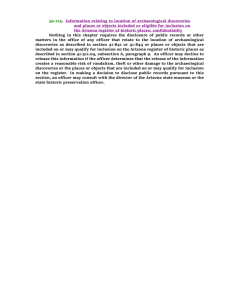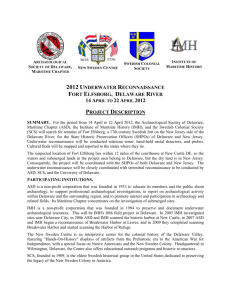06 Harbor Reconnaisance - NC
advertisement
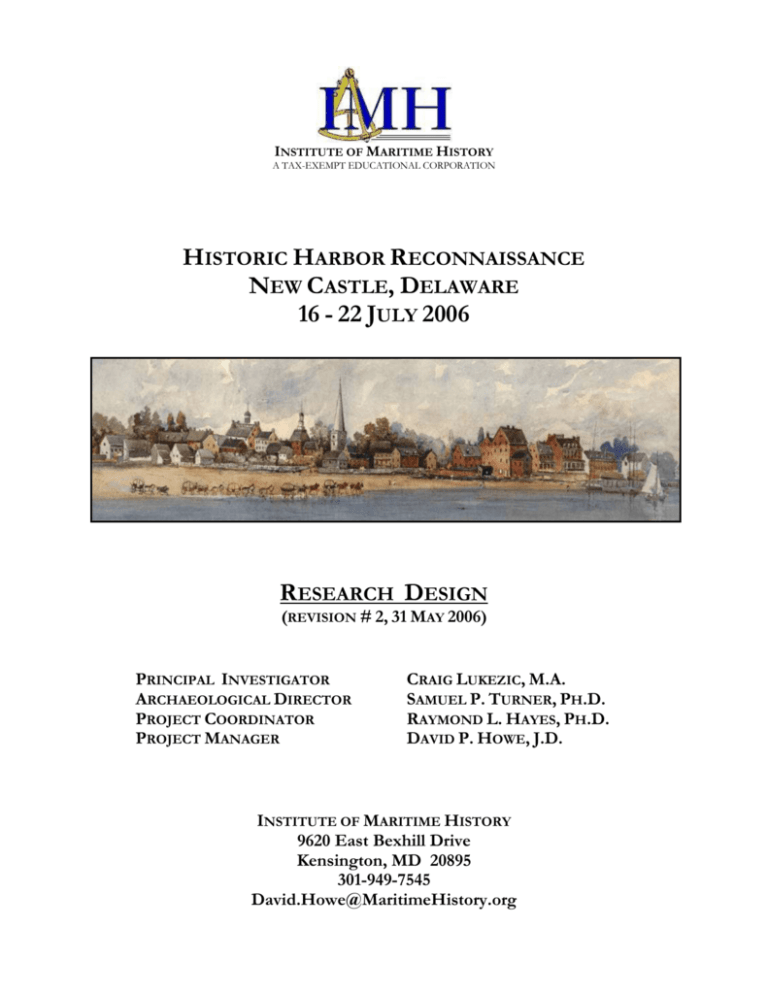
INSTITUTE OF MARITIME HISTORY A TAX-EXEMPT EDUCATIONAL CORPORATION HISTORIC HARBOR RECONNAISSANCE NEW CASTLE, DELAWARE 16 - 22 JULY 2006 RESEARCH DESIGN (REVISION # 2, 31 MAY 2006) PRINCIPAL INVESTIGATOR ARCHAEOLOGICAL DIRECTOR PROJECT COORDINATOR PROJECT MANAGER CRAIG LUKEZIC, M.A. SAMUEL P. TURNER, PH.D. RAYMOND L. HAYES, PH.D. DAVID P. HOWE, J.D. INSTITUTE OF MARITIME HISTORY 9620 East Bexhill Drive Kensington, MD 20895 301-949-7545 David.Howe@MaritimeHistory.org HISTORIC HARBOR RECONNAISSANCE NEW CASTLE, DELAWARE RESEARCH DESIGN I. SUMMARY During the week of 16-22 July 2006, in cooperation with the Delaware Division of Historical and Cultural Affairs, the Archaeological Society of Delaware, the New Castle Community History and Archaeology Program (NC CHAP), and the New Castle Historical Society, IMH plans to conduct an underwater reconnaissance of the Delaware River at New Castle to locate and identify archaeological sites relating to the maritime history that port. The work will be part of our Submerged Historical Inventory Project ("SHIP"). This Research Design describes the rationale, goals, and methodology of the work, the expected product, and some of the principal participants. II. CONTEXT. Founded in 1651 as a Dutch fort on the western side of the Delaware River at 39° 34' North, New Castle was the first source of fresh water for vessels entering the river in colonial days, and became the first capital of Delaware. It passed to English control in the third Anglo-Dutch War, 1684, and remained an active seaport for exactly three centuries. Linked to the Chesapeake Bay by road and later by railroad, New Castle served as a major point for transshipment of cargo and passengers moving from Philadelphia and the northeast to Baltimore and southern points. Its last commercial navigation ended in 1951 when the Delaware Memorial Bridge opened and the ferry service to Penn's Landing, New Jersey, closed. The cupola of the courthouse is the center of a 12-mile circle that defines the northern boundary of the state. Several sets of ice barriers were built at New Castle to protect shipping. The first was funded by a lottery in 1794 and completed about 1800. The most recent barriers were built by the Corps of Engineers in the 1880s of timber faced and topped with stone. A "catwalk" pier from the foot of Delaware Street to one ice barrier was built during World War II by German prisoners of war held at Fort Delaware on Pea Patch Island, five miles downriver. The surviving ice piers were listed on the National Register in 1982 (structure 82002333). The Register lists seven structures, but only five are currently visible. III. PROJECT RATIONALE Surviving structures on shore date from the 17th century and later. It may be expected that comparably significant features survive in the harbor. No archaeological reconnaissance is known to have been conducted in the harbor. States, counties, and municipalities are the first lines of defense for the protection of historic sites that are not on federal lands. A full inventory of submerged historic sites in state waters would greatly facilitate that protection, especially when sudden threats from natural or human causes require an urgent response without time for reconnaissance and research. However, even those states that enjoy publicly funded programs in underwater archaeology generally lack the means proactively to scout their waters for historic resources. Investigation of submerged sites has been limited and inherently reactive. The lack of reconnaissance also means that states often cannot meet the inventory and assessment mandates of the Abandoned Shipwreck Act of 1987 and the National Historic Preservation Act of 1966. By building a working inventory of submerged resources, with particular focus on the discovery and assessment of unknown or undocumented sites, SHIP offers the states a solution for that problem. Guided by professional archaeologists and subject to full control by the cognizant State Historic Preservation Officer ("SHPO") IMH's trained volunteers provide the manpower and assets to reconnoiter and inventory those resources at no cost to the state. In a pilot project in Maryland in 2002 through 2005, for example, eight volunteers investigated more than 45 targets, reported six wrecks, and assessed the other targets as natural or as buried so deeply that they could not be found and thus were not exposed to immediate threat. In five days of field work in Delaware, 13-18 November 2005, six volunteers investigated 20 suspected sites and reported structure at five of them. IV. GOALS. Our reconnaissance project has the following specific goals: Develop an inventory of submerged historic sites in the harbor area; Determine the geographic extent of that area, based on archaeological finds; Map each feature, and determine its type, overall dimensions, material, propulsion (if any), and other salient characteristics; Report all sites to the SHPO in whatever format or manner the SHPO prefers; Develop a bibliography of archival sources regarding the history of the harbor; Develop a cadre of trained, local, volunteer divers and researchers to continue research; and Ensure that participants do not disturb sites or disclose them to others who might. V. METHODOLOGY A. Field work. 1. General procedures. Areas for reconnaissance will be systematically assessed using standard, no impact, Phase I methodology. In order to locate cultural remains and establish baseline data on the nature and condition of identified resources, remote sensing with sidescan sonar and magnetometers and reconnaissance by divers will be the initial activities in each area. Mechanical methods of location (dragging, grappling, etc.) are destructive and will not be used. Divers will investigate each target, categorize it as cultural or natural, and record the GPS coordinates for the center of each cultural site. Identifiable or suspected cultural remains will be investigated further by standard archaeological techniques. Divers will record the exposed material; measure the site dimensions, depth, and orientation; measure scantlings; and prepare field drawings as needed. This information will populate the database and provide useful data to the SHPO for site management, including the selection of sites for further investigation. Material will not be not moved or recovered unless specifically directed by the SHPO and supervised by a qualified archaeologist appointed or approved by the SHPO. In that event the SHPO will provide all necessary permits, conservation, storage, and curation. 2. Specific procedures for New Castle. a. July 16. Starting at 0900 we will conduct a general reconnaissance by sidescan sonar of the entire harbor area from shore to the shipping channel. We will buoy each anomaly and investigate it with divers. The sonar search area will be approximately 0.6 square mile, as follows: b. July 17-21. We will finish mapping all anomalies in the sonar search area, and then conduct a systematic search by divers in selected inshore areas that appear to offer the most promise of significant finds. Diver searches will be conducted on guide ropes. Those search areas will lie outside and inside the line of ice barriers but will not extend as far as the sonar search area. They may include the following: Diver searches will be conducted on guide ropes: We will deploy a 30-meter guide line with a heavy anchor at each end and 10-pound mushroom anchors at the 10- and 20-meter points. We will record a GPS position for each end. Dive teams will conduct five circle searches around each anchor, using a 5-meter radius line marked at 1-meter increments. If they find an artifact they will note the type of artifact, the anchor (0, 1, 2, or 3), the radius, and the compass bearing from the artifact to the anchor. If the artifact is worth further investigation they will mark it with a pop buoy. c. July 22. We will finish mapping any unfinished targets, offer a short oral summary of our work and findings, and depart New Castle about 1800. Schedule: Friday, 14 July Saturday, 15 July Sunday, 16 July Sunday, 16 July — through — Saturday, 22 July Saturday, 22 July Sunday, 23 July time 2000 0600 2257 0134 0200+ 0630 0845 0900 1700 1800 1900+ 0032 1730 event tasks provision and fuel Roper all spares and supplies on board underway from Tall Timbers (assume 6.7 knots SoA) pass Old Town Point enter C&D Canal pass Reedy Point exit C&D Canal scan east side of Pea Patch Island dock at New Castle, catwalk pier meet divers, load gear see detailed schedule, attached underway dock at New Castle underway (assume 6.7 knots SoA) scan west side of Pea Patch Island pass Old Town Point exit C&D Canal dock at Tall Timbers MD Tide predictions at New Castle: 39° 39.4' N, Sunday, 16 July 0418 + 5.8 ft. Tuesday, 18 July 1131 + 0.0 ft. 1658 + 5.5 ft. 2356 + 0.4 ft. Monday, 17 July 0516 + 5.6 ft. Wed., 19 July 1221 + 0.1 ft. 1756 + 5.7 ft. 075° 33.7' W 0056 + 0.5 ft. Thursday, 20 July 0617 + 5.3 ft. 1312 + 0.1 ft. 1854 + 5.8 ft. 0158 + 0.5 ft. Friday, 21 July 0718 + 5.1 ft. 1407 + 0.2 ft. 1953 + 5.8 ft. Saturday, 22 July 0259 0819 1502 2050 0359 0917 1557 2145 0456 1012 1651 + 0.5 ft. + 5.0 ft. + 0.3 ft. + 5.9 ft. + 0.5 ft. + 5.0 ft. + 0.4 ft. + 5.9 ft. + 0.4 ft. + 4.9 ft. + 0.4 ft. B. Inventory 1. Structure and sources. An initial inventory has been started. It will be updated and supplemented as research and field work proceed. The inventory is currently written in Microsoft Access but can be converted to a GIS program for data management and utilization. Target locations and identities for the initial inventory came from numerous sources, including NOAA’s Automated Wreck and Obstruction Information Service ("AWOIS") database, other NOAA assets, maritime and local museums and historical societies, oral histories, and other sources of historical, hydrographic, and reconnaissance data. Additional sources need to be identified and examined, including Corps of Engineers records, National Register nominations, state and local archives, and private collections. Those data have not previously been compiled into one unified database. 2. Bibliography. All archival sources that are found to be pertinent will be listed in a bibliography, and summarized in the database, to facilitate future research. 3. Proprietary rights. The project is for the benefit of the SHPO. IMH will not claim proprietary rights in the inventory or bibliography against the state. 4. Confidentiality. Because the disclosure of site locations and other data might expose sites to disturbance or looting, the inventory will be held in strict confidence and will not be disclosed to anyone except the SHPO and designees, and IMH members actively engaged in the project. All participants sign a contract not to disturb sites, not to recover or receive any material from sites, not to record site locations, not to bring personal navigational equipment (including GPS units) onto sites, and not to disclose the existence, nature, or location of any site. C. Reports. As desired by the SHPO, individual sites will be reported on state site forms or on IMH forms, which contain the data fields, used in the database. An updated edition of the database will be sent to the SHPO. IMH will also file a summary report with the SHPO to include the general areas and characteristics of sites that were investigated, with recommendations for future work. To allow wide dissemination this report will not include precise site locations. IMH will also update its web page (www.maritimehistory.org) to allow project reports to be accessible in real time to an international audience. VI. PARTICIPANTS Because SHIP seeks to promote archaeological stewardship among divers and other members of the public, the general intention is to invite and embrace as many participating and collaborating institutions and individuals as feasible, subject always to the prohibition against disturbance or disclosure of sites. Continuous efforts will be made to recruit volunteers though colleges, museums, archaeological and historical societies, dive clubs, dive shops, advertisements, and word of mouth. Membership in IMH is open to all persons interested in maritime history, underwater archaeology, cultural resource management, or diving, if they pay membership dues and agree by contract not to disturb or disclose archaeological sites. See Appendix 1. Participation in SHIP normally requires membership in IMH or a cooperating institution with comparable training and an agreement not to disturb or disclose sites in order to ensure that the highest standards of confidentiality and field competence are maintained. In specific cases individual guests, especially government officials, and professionals or active avocationals in underwater archaeology and related fields, may be invited onto the project. Project divers need a dive certification from a nationally recognized dive training agency, and must be competent and comfortable in the conditions they undertake. Divers should have basic archaeological training, which can be obtained from undergraduate or graduate schools, the Maritime Archaeological and Historical Society (MAHS), the Nautical Archaeology Society (NAS), or other sources. A. Principal Investigator. Craig Lukezic, M.A. Mr Lukezic is an archaeologist with the Delaware Department of State, Division of Historic and Cultural Affairs. He will supervise field work and approve all assessments and reports. email: craig.lukezic@state.de.us phone: 302-739-5685 (w) B. IMH volunteers. IMH is a 501(c)(3) corporation that was founded in 1993. IMH members on the New Castle project include: 1. Archaeological Director: Samuel P. Turner, Ph.D. IMH President Dr Turner is the Archaeological Director of the Lighthouse Archaeological Maritime Program (LAMP) at the St.Augustine Lighthouse and Museum, St.Augustine, Florida. He supervises the project design and will review all assessments and reports. email: Sam_Turner_2000@yahoo.com 2. Project Coordinator: phone: 904-829-0745 (w) Raymond L. Hayes, Ph.D. IMH Member Dr Hayes is a retired professor and a highly experienced diver. He has participated in many harbor surveys in the Netherlands Antilles and Maryland, and many environmental and archaeological projects in the Caribbean. He will coordinate and conduct field work and research email: LizHayes@earthlink.net 3. Project Manager: David P. Howe, J.D. phone: 301-585-5892 (h, w) IMH Secretary An editor, admiralty lawyer, and retired naval officer, Mr Howe will recruit volunteers, conduct field work, operate research vessels, compile field data, draft reports, and manage the database. email: David.Howe@MaritimeHistory.org 4. other volunteers: phone: 301-949-7545 (h, w) The following individuals and others are scheduled to participate: Joyce Steinmetz is a highly experienced diver and a member of the Delaware Marine Archaeology Society (DMAS). William I. Taylor is a member and past president of DMAS and a charter member of SHIP. William E. Utley has worked on many underwater archaeological projects, including excavation of the Belle, a French "ship of discovery" that foundered in 1686 in Matagorda Bay, Texas. See www.thc.state.tx.us/belle. LT Jeremy B. Weirich, NOAA, is an underwater archaeologist, formerly with NOAA's Office of Ocean Exploration, now on detail from NOAA to the Senate Appropriations Committee. His involvement in this project is personal and does not imply any involvement, support, or sanction by NOAA or the federal government. 5. Collaborators. The Archcaeological Society of Delaware, the Historical Society of Delaware, the New Castle History and Archaeology Program, the New Castle Historiucal Society, and interested local divers have been invited to participate in field work and research. APPENDIX 1 Page 1 PARTICIPANT DATA Date: (to be completed by all participants upon joining the project) PARTICIPANT: Name: title Residence: first middle initial last suffix street address city state ( ) home phone ZIP ( ) cell phone ( fax ) Email: Diver? yes / no If yes, provide: year of birth: highest dive certification level: diving insurance: years diving: agency: agency: year: expiration date archaeological training, if any source: year: AAUS diver? yes / no year: type: year of last diving physical: year of CPR certification: year of first aid certification: year of O2 certification: Other diving and archaeological training: Notes and comments: EMERGENCY CONTACT: Name: Residence: title first Relationship to participant: middle initial last suffix street address city ( ) work phone state ( ) cell phone ZIP ( ) home phone ( fax Email: ALSO COMPLETE AND SIGN PAGES 2 AND 3 OF THIS APPENDIX. ) APPENDIX 1 Page 2 PARTICIPATION AGREEMENT (to be completed by all project participants) I, ____________________________________ volunteer to participate in archaeological projects conducted by the Institute of Maritime History (IMH). In consideration of being allowed to participate I hereby agree as follows: 1. IMH projects are entirely voluntary. I will not be paid or reimbursed for services or expenses. 2. I will treat all shipwrecks and other historic underwater sites, and all artifacts and information pertaining to them, as archaeological resources of the state where they lie. 3. I will not disclose the existence, location, or nature of any such site to anyone except the State Historic Preservation Officer, his or her agents or designees, and IMH participants. 4. I will not excavate or disturb any archaeological site, and will not remove or receive any artifact from any such site, except as directed and supervised by the SHPO or his or her agent or designee. 5. I will not record the location of any archaeological site in writing or electronic memory. I will not use or bring a personal GPS unit or other device on any project or site, unless specifically requested for project purposes. If I record such information or bring or use such device I will erase the location and other site data when requested to do so. 6. I will not violate any federal or state law regarding the treatment of submerged historic resources. I will report to the State Historic Preservation Officer any illegal excavation, disturbance, or removal of artifacts from any such site which I observe or learn about. 7. I may terminate my participation in IMH at any time, but my agreement not to disclose or disturb any archaeological site will remain in effect and fully enforceable even after my participation terminates. 8. I recognize, accept, and agree that any act which violates this Agreement may cause significant or irreparable harm to the affected site(s), to the state, and to IMH; and that such an act may be grounds for my expulsion from IMH and may entail serious civil or criminal liabilities under federal or state law. 9. I knowingly and voluntarily assume all risks of injury or loss to person, life, or property that I may suffer in connection with IMH activities and in travel to or from such activities. I voluntarily and forever waive, discharge, and release all claims of injury or loss to person, life, or property against IMH, the other project participants, and the state. 10. If diving, I warrant and represent that I have been well trained and am proficient and capable in diving; that I understand the dangers and voluntarily assume the risks of diving and archaeological diving generally, and of the specific diving activities in which I choose to participate; that I possess the knowledge and experience needed to fully assess those dangers and risks, and that I possess the training and skills needed to conduct those diving activities safely. I understand that I may decline to participate in any dive or any project activity, at any time, for any reason or for no reason. 11. I make the foregoing agreements, affirmations, warranties, and representations in order to induce IMH and other participants to allow me to participate. I will indemnify, hold harmless, and defend IMH, all other project participants, and the state from any and every claim arising out of my participation. 12. This Agreement shall apply to and bind me, my estate, heirs, executors, personal representatives, beneficiaries, attorneys, agents, underwriters, and all others who may have any derivative claim for recovery on my behalf. 13. I have read this agreement. I understand it includes an assumption of risk and a waiver of liability and has other legal effects. I understand this agreement, and I will be bound by its contents. AGREED: Signature: ACCEPTED BY IMH: Date: Initials: Date: APPENDIX 1 Page 3 MEDICAL STATEMENT (to be completed by all divers) Name of participant: This statement discusses some potential risks involved in scuba diving. Your signature on this statement is required for you to participate in diving activities. Read and understand this statement before signing it, and complete the medical history section. If you are a minor, you must have this statement signed by a parent or legal guardian. Diving can be physically demanding. When performed with correct techniques it is very safe, but when established safety procedures are not followed there are dangers. To dive safely you must not be extremely overweight or physically unfit. Diving can be strenuous under certain conditions. Your respiratory and circulatory systems must be in good health. All body air spaces must be normal and healthy. A person with heart trouble, a current cold or congestion, epilepsy, asthma, a severe medical problem, or who is under the influence of alcohol or drugs must not dive. If taking medication, consult your doctor before diving. Improper use of scuba equipment or other dive gear can result in serious injury or death. You must be thoroughly instructed in its use under the direct supervision of a qualified instructor to use it safely. MEDICAL HISTORY The purpose of this medical questionnaire is to find out if you should be examined by a doctor before participating in diving activities. A positive response to a question does not necessarily disqualify you from diving. A positive response means that there is a preexisting condition that may affect your safety while diving and you must obtain guidance from your physician. Please answer the following questions on your medical history with a Yes or a No. If you are not sure, answer Yes. If any of these items apply you must provide a physician's approval prior to diving on an IMH project. If you have any questions regarding this Medical Statement or Medical History, review them with the Diving Safety Officer before signing. ____ Could you be pregnant or are you attempting to become pregnant? ____ Do you regularly take any prescription or nonprescription medications (except birth control)? ____ Are you over 45 years of age and have one or more of the following : ___ currently smoke a pipe, cigars, or cigarettes? ___ have a high cholesterol level? ___ have a family history of heart attacks or strokes? Have you ever had or do you currently have ... ____ Asthma, wheezing with breathing, or wheezing with exercise? ____ Frequent or severe attacks of hay fever or allergy? ____ Frequent colds, sinusitis or bronchitis? ____ Any form of lung disease? ____ Pneumothorax (collapsed lung)? ____ History of chest surgery? ____ Claustrophobia or agoraphobia (fear of closed or open spaces)? ____ Behavioral health problems? ____ Epilepsy, seizures, convulsions or do you take medications to prevent them? ____ Recurring migraine headaches or do you take medications to prevent them? ____ History of blackouts or fainting (full / partial loss of consciousness)? ____ Frequent motion sickness (seasick, carsick, etc.) ____ A diving accident or decompression sickness? ____ History of recurrent back problems? ____ History of back surgery? ____ Diabetes? ____ History of back, arm or leg problems following surgery, injury or fracture? ____ Inability to perform moderate exercise (walk one mile within 12 minutes)? ____ High blood pressure, or do you take medicine to control blood pressure? ____ Heart disease? ____ History of heart attacks? ____ History of angina or heart or blood vessel surgery? ____ History of ear or sinus surgery? ____ History of ear disease, hearing loss, or problems with balance? ____ Problems equalizing (popping) ears during airplane or mountain travel? ____ History of bleeding or other blood disorders? ____ Any type of hernia? ____ History of ulcers or ulcer surgery? ____ Colostomy? ____ History of drug or alcohol abuse? The above information is accurate to the best of my knowledge. signature of participant, or parent or guardian date
